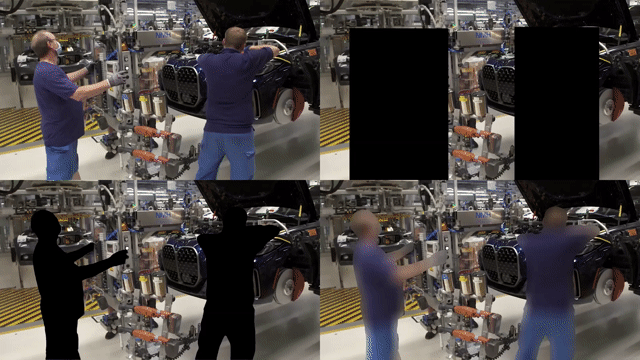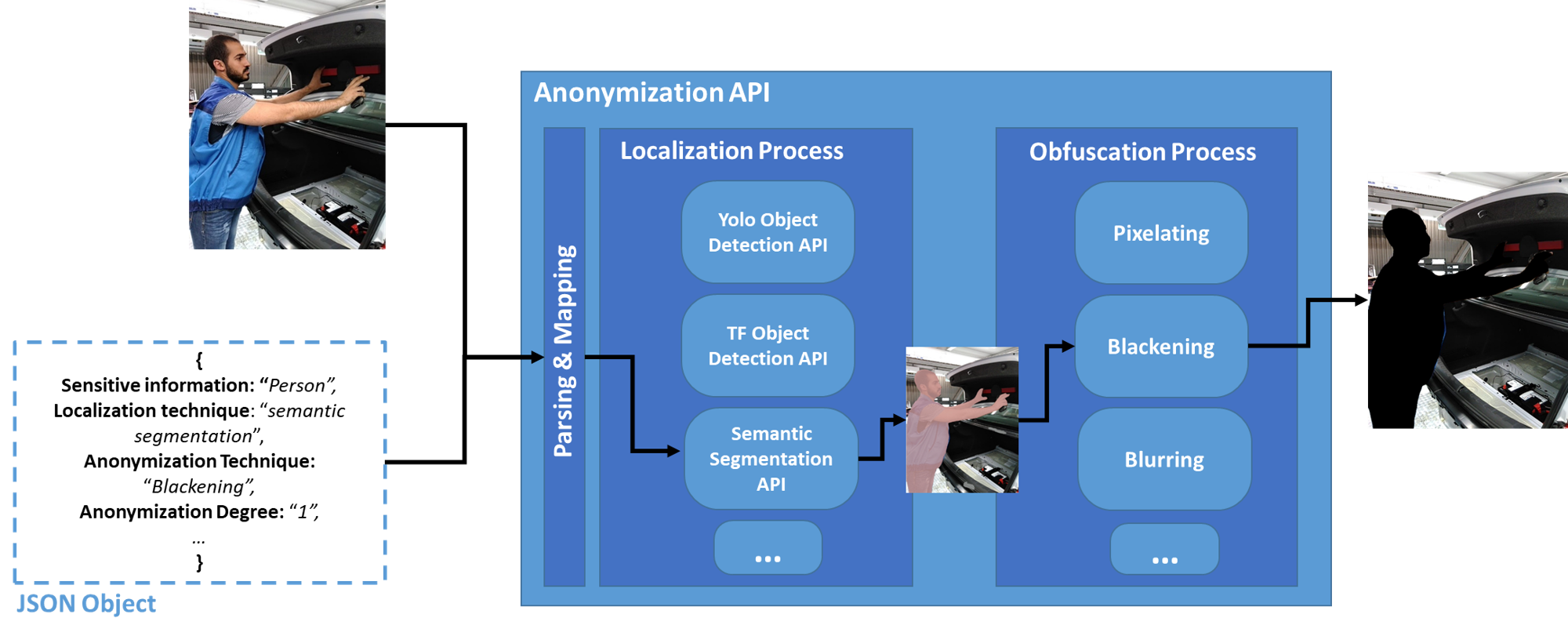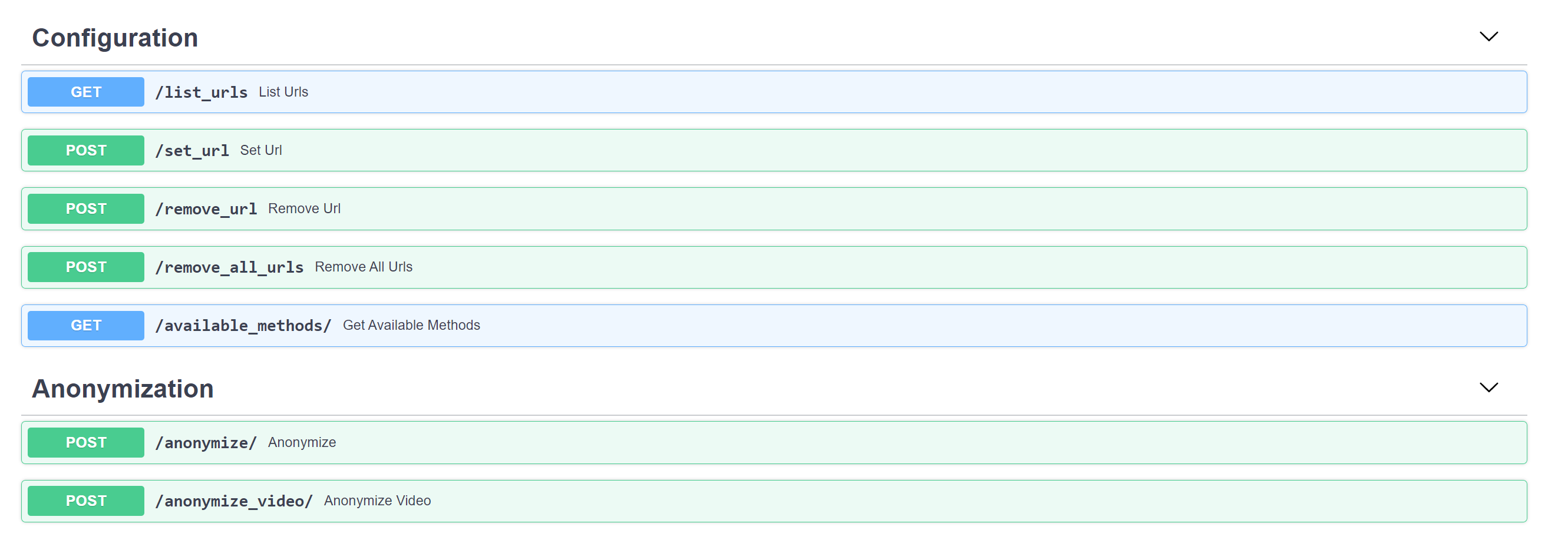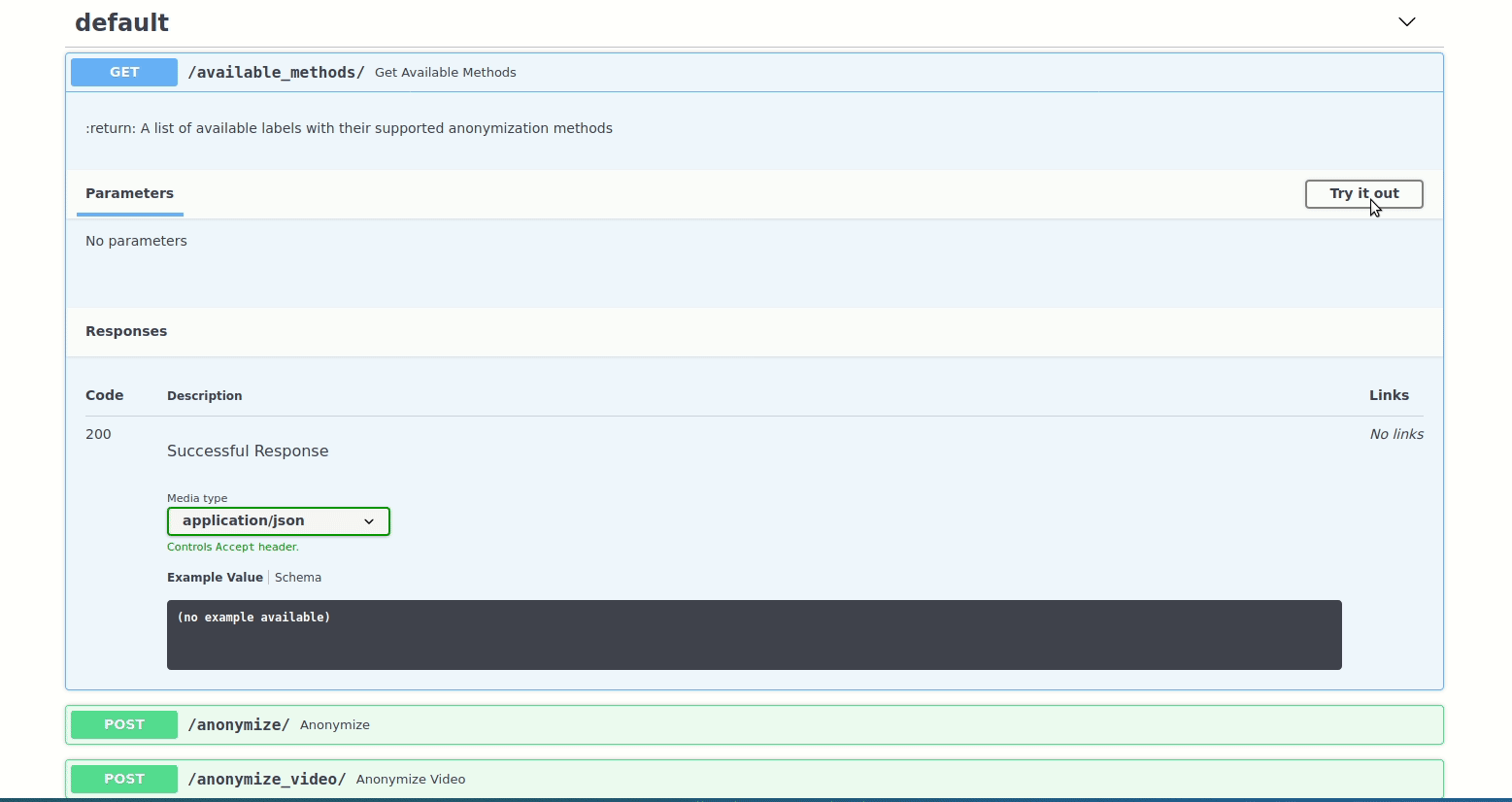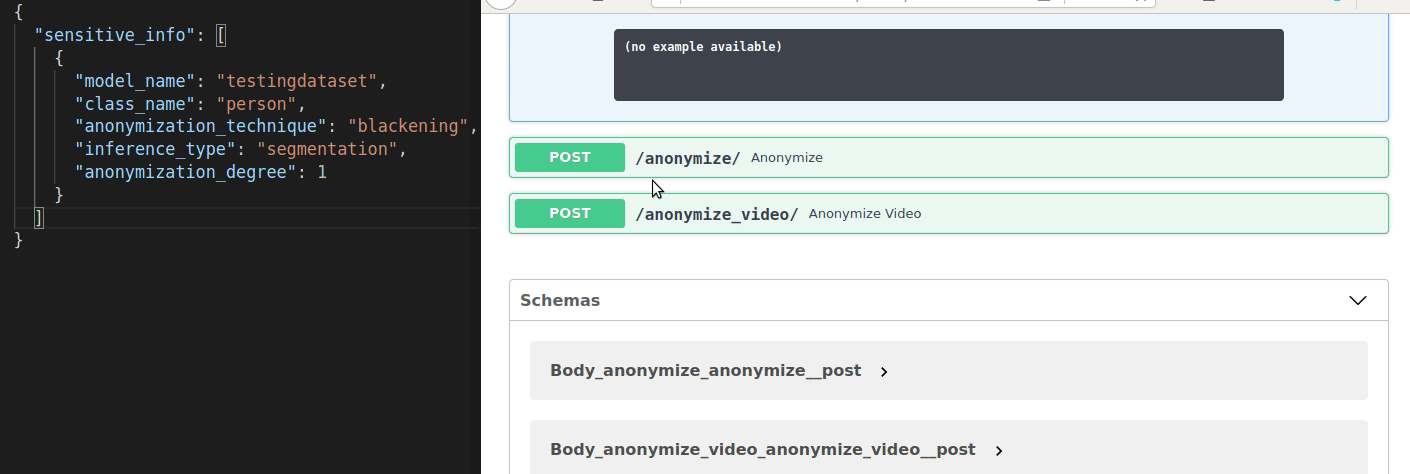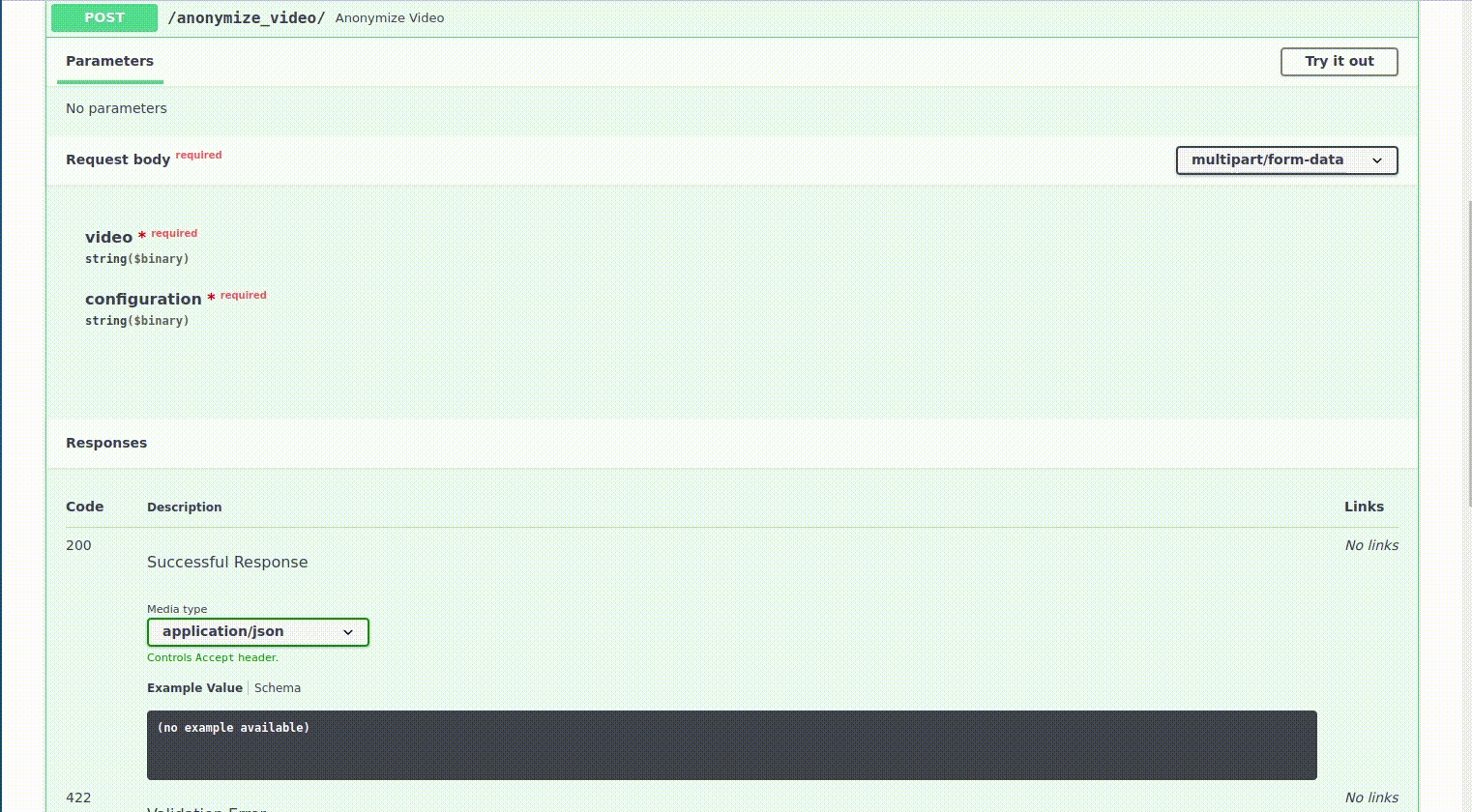Data privacy and individuals’ anonymity are and always have been a major concern for data-driven companies.
Therefore, we designed and implemented an anonymization API that localizes and obfuscates (i.e. hides) sensitive information in images/videos in order to preserve the individuals' anonymity. The main features of our anonymization tool are the following:
- Agnostic in terms of localization techniques: our API currently supports Semantic segmentation or Object Detection.
- Modular in terms of sensitive information: the user can train a Deep Learning (DL) model for object detection and semantic segmentation to localize the sensitive information she/he wishes to protect, e.g., individual's face or body, personal belongings, vehicles...
- Scalable in terms of anonymization techniques: our API currently supports pixelating, blurring, blackening (masking). Also, additinal anonymization techniques can be configured as stated below. For the highest level of privacy, we recommend using the blackening technique with degree 1.
- Supports DL-based models optimized via the Intel® OpenVINO™ toolkit v2021.1 for CPU usage: DL-based models optimized and deployed via the Openvino Segmentation Inference API and the Openvino Detection Inference API can also be used.
- Compatible with the BMW Deep Learning tools: DL models trained via our training and deployed via our inference APIs are compatible with this anonymization API.
Our anonymization API receives an image along with a JSON object through which the user specifies mainly:
- The sensitive information she/he wishes to obfuscate.
- The anonymization technique.
- The anonymization degree.
- The localization technique.
You can deploy the anonymization API either:
- As a standalone docker container which can be connected to other inference APIs (object detection or semantic segmentation) deployed within a standalone docker container as well.
- As a network of docker containers along with other inference APIs running on the same machine via docker-compose. (please check the following link for the docker-compose deployment).
- docker
- docker-compose
docker --versiondocker-compose --versionTo install Docker and Docker Compose on Ubuntu, please follow the link.
To install Docker on Windows, please follow the link.
P.S: For Windows users, open the Docker Desktop menu by clicking the Docker Icon in the Notifications area. Select Settings, and then Advanced tab to adjust the resources available to Docker Engine.
As mentioned before, this container can be deployed using either docker or docker-compose.
-
If you wish to deploy this API using docker-compose, please refer to following link. After deploying the API with docker compose, please consider returning to this documentation for further information about the API Endpoints and use configuration file sample sections.
-
If you wish to deploy this API using docker, please continue with the following docker build and run commands.
In order to build the project run the following command from the project's root directory:
docker build -t anonymization_api -f docker/dockerfile .In order to build the image behind a proxy use the following command in the project's root directory:
docker build --build-arg http_proxy='your_proxy' --build-arg https_proxy='your_proxy' -t anonymization_api -f ./docker/dockerfile .To run the API, go to the API's directory and run the following:
sudo docker run -itv $(pwd)/src/main:/main -v $(pwd)/jsonFiles:/jsonFiles -p <port_of_your_choice>:4343 anonymization_apisudo docker run -itv $(pwd)/src/main:/main -v $(pwd)/jsonFiles:/jsonFiles --env HTTP_PROXY="" --env HTTPS_PROXY="" --env http_proxy="" --env https_proxy="" -p 5555:4343 anonymization_apidocker run -itv ${PWD}/src/main:/main -v ${PWD}/jsonFiles:/jsonFiles -p <port_of_your_choice>:4343 anonymization_apiThe API file will be run automatically, and the service will listen to http requests on the chosen port.
To see all available endpoints, open your favorite browser and navigate to:
http://<machine_IP>:<docker_host_port>/docs
Set the URL of the inference API that you wish to connect to the Anonymization API. If the specified URL is unreachable due to connection problems, it will not be added to the JSON url_configuration file. The URL should be specified in the following format "http://ip:port/".
Returns the URLs of the inference APIs that were already configured via the /set_url POST request.
Removes the specified URL from the JSON url_configuration file
Removes all available urls from the JSON url_configuration file
After setting the inference URLs via the /set_url request, the user can view the Anonymization API's configuration by issuing the /available_methods request. Mainly the user can view (i) the supported sensitive information (label_names) , (ii) the supported localization techniques, (iii) the inference URLs and (iv) the DL model name that are configured in the deployed anonymization API as seen below.
Anonymizes the input image based on the user's JSON configuration file
Anonymizes a video based on the user's sensitive info and save the anonymized video in src/main/anonymized_videos under <original_video_name>_TIMESTAMP.mp4
The video might take a while, actually you can estimate the time that it may take by using the following formula: Video_Anonymization_Time = Video_Length x Number_Of_Frames_Per_Second x Anonymization_Time_Of_Each_Frame
In order to anonymize an image, the user should specify the different details in the user's JSON configuration file
Please check a sample in the below image:
Note that the URL field is an optional field that you can add in case you wanted to use a specific URL of a running API. You can just add the URL as an optional field in this file as shown in the first sensitive info. In case this field is not specified, the URL defined in the url_configuration.json file will be used by default if it matches all the requirements.
Please refer to the following link add new technique documentation for more information on how to add a new anonymization technique to the APIs with common and custom labels.
| GPU | Network | Width | Height | Inference Time (s) | Anonymization Time (s) | Total Time (s) |
|---|---|---|---|---|---|---|
| Titan RTX | yolov4 | 640 | 768 | 0.2 | 0.07 | 0.27 |
| Titan RTX | yolov4 | 1024 | 768 | 0.4 | 0.14 | 0.54 |
| Titan RTX | yolov4 | 2048 | 1024 | 1.2 | 0.6 | 1.8 |
| Titan RTX | yolov4 | 3840 | 2160 | 4.8 | 0.6 | 5.4 |
The model was trained with the TensorFlow Object Detection API (TF version 1.14) and then converted to OpenVINO IR using Intel® OpenVINO™ toolkit v2021.4
Results may vary. For workloads and configurations visit: www.intel.com/PerformanceIndex and Legal Information.
| CPU | Network | Precision | Width | Height | Inference Time (s) | Anonymization Time (s) | Total Time (s) for Avg, Max, Min |
|---|---|---|---|---|---|---|---|
| Intel Core i7-1185G7 |
Faster R-CNN Input Shape: [3,600,600] |
FP32 | 1024 | 768 | 0.51 | 0.09 | 0.60, 0.67, 0.54 |
| Intel Core i7-1185G7 |
Faster R-CNN Input Shape: [3,600,600] |
FP32 | 2048 | 1536 | 0.56 | 0.24 | 0.80, 0.97, 0.70 |
| Intel Core i7-1185G7 |
Faster R-CNN Input Shape: [3,600,600] |
INT8 | 1024 | 768 | 0.16 | 0.09 | 0.25, 0.27, 0.22 |
| Intel Core i7-1185G7 |
Faster R-CNN Input Shape: [3,600,600] |
INT8 | 2048 | 1536 | 0.19 | 0.24 | 0.43, 0.56, 0.36 |
| GPU | Network | Width | Height | Inference Time (s) | Anonymization Time (s) | Total Time (s) |
|---|---|---|---|---|---|---|
| Titan RTX | psp resnet 101 | 640 | 768 | 0.2 | 0.8 | 1.1 |
| Titan RTX | psp resnet 101 | 1024 | 768 | 0.3 | 0.8 | 1.1 |
| Titan RTX | psp resnet 101 | 2048 | 1024 | 0.9 | 1.0 | 1.9 |
| Titan RTX | psp resnet 101 | 3840 | 2160 | 2.0 | 3.0 | 5.0 |
-
You may encounter the below error when running the docker container at startup in standalone version or docker-compose version

-
In case you do, please make sure that the URL of the inference APIs listed in the
jsonFiles/url_configuration.jsonare still recheable. A possible solution would be to emptyjsonFiles/url_configuration.jsonas seen below before starting the container:{ "urls": [ ] }
If you use this repository in your research, consider citing it using the following Bibtex entries:
@inproceedings{Tekli2021DesigningAE,
title={Designing and evaluating anonymization techniques for images and relational data streams via Machine Learning approaches at BMW Group. (Conception et {\'e}valuation de techniques d'anonymisation des images et des flux de donn{\'e}es relationnels via des approches d'apprentissage automatique {\`a} BMW Group)},
author={Jimmy Tekli},
year={2021},
url={https://api.semanticscholar.org/CorpusID:266756928}
}
and
@misc{bmwanotool,
author = {BMW TechOffice MUNICH},
title = {BMW Anonymization Tool},
howpublished = {\url{https://github.com/BMW-InnovationLab/BMW-Anonymization-API}},
year = {2019},
}
Ghenwa Aoun
Antoine Charbel, inmind.ai, Beirut, Lebanon
Roy Anwar
Fady Dib
Jimmy Tekli, BMW Innovation Lab, Munich, Germany
